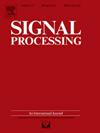Cauchy–Gaussian maximum mixture correntropy Kalman filter with component-by-component construction
IF 3.4
2区 工程技术
Q2 ENGINEERING, ELECTRICAL & ELECTRONIC
引用次数: 0
Abstract
The Kalman filter (KF) systematically optimizes the quasi-Monte Carlo (QMC) sampling points by employing a component-by-component (CBC) construction principle tailored to specific integration dimensions and accuracy requirements. This optimization enhances the approximation accuracy of Gaussian-weighted multidimensional integrals (GMIs) within the context of the KF. However, the KF based on CBC sampling points uses the minimum mean square error (MMSE) criterion, which can lead to significant estimation bias in the presence of non-Gaussian noises. To address this issue, this paper first proposes a novel Cauchy–Gaussian maximum mixture correntropy Kalman filter with component-by-component construction (CGMCKF-CBC) by the designed novel Cauchy–Gaussian maximum mixture correntropy (CGMC). Unlike the traditional maximum mixture correntropy criterion (MMCC), the CGMC uses the mixture of Cauchy kernel and Gaussian kernel as the cost function, and updates the posteriori estimates by the form of fixed-point iteration. Next, to further address the parameters selection issue existing in CGMCKF-CBC, an adaptive optimization strategy is proposed to determine appropriate parameters, resulting a variable CGMCKF-CBC (VCGMCKF-CBC). Then, the convergence analysis and complexity evaluation of CGMCKF-CBC are also conducted. Finally, two simulation examples are conducted in non-Gaussian noises environments to validate the excellent filtering accuracy and robustness of CGMCKF-CBC and VCGMCKF-CBC.
求助全文
约1分钟内获得全文
求助全文
来源期刊

Signal Processing
工程技术-工程:电子与电气
CiteScore
9.20
自引率
9.10%
发文量
309
审稿时长
41 days
期刊介绍:
Signal Processing incorporates all aspects of the theory and practice of signal processing. It features original research work, tutorial and review articles, and accounts of practical developments. It is intended for a rapid dissemination of knowledge and experience to engineers and scientists working in the research, development or practical application of signal processing.
Subject areas covered by the journal include: Signal Theory; Stochastic Processes; Detection and Estimation; Spectral Analysis; Filtering; Signal Processing Systems; Software Developments; Image Processing; Pattern Recognition; Optical Signal Processing; Digital Signal Processing; Multi-dimensional Signal Processing; Communication Signal Processing; Biomedical Signal Processing; Geophysical and Astrophysical Signal Processing; Earth Resources Signal Processing; Acoustic and Vibration Signal Processing; Data Processing; Remote Sensing; Signal Processing Technology; Radar Signal Processing; Sonar Signal Processing; Industrial Applications; New Applications.
 求助内容:
求助内容: 应助结果提醒方式:
应助结果提醒方式:


